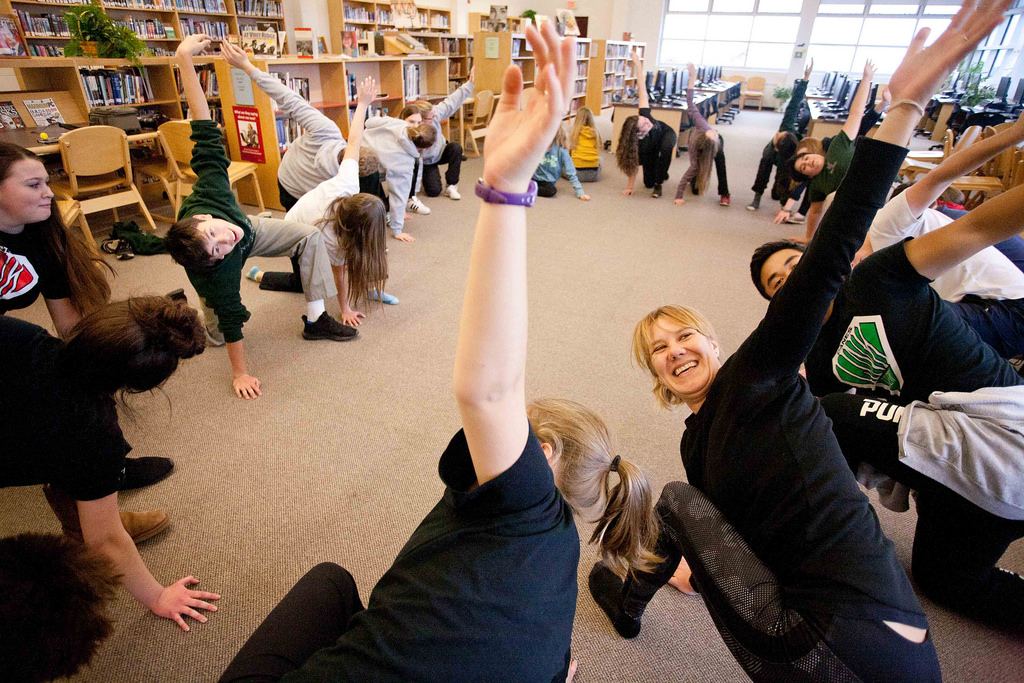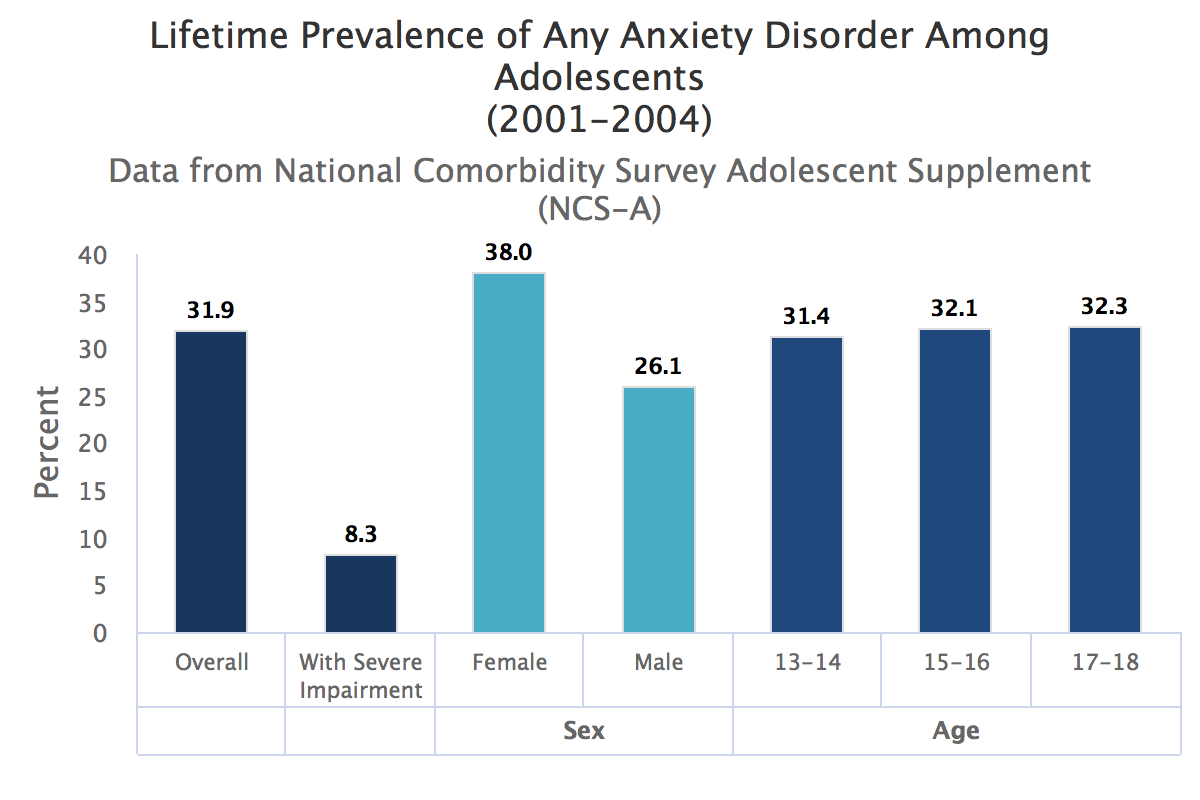 Many public schools have embraced mindfulness practices into daily activities. From teaching children to take belly breaths to body scans, education is seeing positive results in their students.
Many public schools have embraced mindfulness practices into daily activities. From teaching children to take belly breaths to body scans, education is seeing positive results in their students.
Another trend in education is to incorporate yoga into physical education and regular classroom schedules. Research backs up the benefits of yoga teachers and students experience from regular asana and pranayama practice.
Students today are more anxious than previous generations. Children feel pressure to achieve as well as disconnection.((http://madelinelevine.com/the-price-of-privilege/)) According to the Anxiety and Depression Association of America, “Research shows that untreated children with anxiety disorders are at higher risk to perform poorly in school, miss out on important social experiences, and engage in substance abuse.”((https://adaa.org/about-adaa/press-room/facts-statistics))
The National Insitute of Mental Health reports that 31.9% of adolescents have some form of an anxiety disorder. Girls are more affected than boys.((https://www.nimh.nih.gov/health/statistics/any-anxiety-disorder.shtml))

A new study conducted at Tulane University found school yoga may reduce anxiety in students.((http://www.mothering.com/articles/study-school-based-yoga-may-lead-to-anxiety-reduction/?utm_medium=email&utm_campaign=Mothering.com_new-content-unsold&utm_source=Mothering.com20180416)) Researchers worked with a small sample of third graders in New Orleans that had been screened for anxiety. They selected this younger age because third grade is a time when the curriculum becomes more challenging and peer/social relationships experience more drama.
The researchers write, “..school-aged children report having numerous stressors in their day-to-day experience, including such concerns as poor academic performance, peer exclusion and social pressure, being bullied or teased,3 and homework.4,5“((https://www.dovepress.com/effect-of-mindfulness-and-yoga-on-quality-of-life-for-elementary-schoo-peer-reviewed-fulltext-article-PRBM))
Two groups of students were followed: a control group of 32 and the intervention group of 20.
The intervention group of 20 students participated in small group yoga/mindfulness activities for eight weeks using a Yoga Ed curriculum. Students attended the small group activities at the beginning of the school day. The sessions included breathing exercises, guided relaxation and several traditional yoga poses appropriate for children.
Researchers evaluated each group’s health-related quality of life before and after the intervention, using two widely recognized research tools. The Brief Multidimensional Students’ Life Satisfaction Scale-Peabody Treatment Progress Battery version was used to assess life satisfaction, and the Pediatric Quality of Life Inventory was used to assess psychosocial conditions and emotional well-being at the beginning, middle and end of the study.
“The intervention improved psychosocial and emotional quality-of-life scores for students, as compared to their peers who received standard care,” said principal author Alessandra Bazzano, associate professor of global community health and behavioral sciences at Tulane University School of Public Health. “We also heard from teachers about the benefits of using yoga in the classroom, and they reported using yoga more often each week, and throughout each day in class, following the professional development component of intervention.”((http://news.tulane.edu/pr/school-based-yoga-can-help-children-better-manage-stress-and-anxiety))
The study was published in the April 2018 edition of the peer-reviewed journal Psychology Research and Behavior Management.
My daily yoga has helped my anxiety. It is a known benefit for all ages.
CLINICAL RESEARCH ON THE YOGA’S ABILITY TO REDUCE ANXIETY
Harvard Medical School summarizes research done on the benefits of yoga for anxiety and depression in adults:
By reducing perceived stress and anxiety, yoga appears to modulate stress response systems. This, in turn, decreases physiological arousal — for example, reducing the heart rate, lowering blood pressure, and easing respiration. There is also evidence that yoga practices help increase heart rate variability, an indicator of the body’s ability to respond to stress more flexibly…
In a German study published in 2005, 24 women who described themselves as “emotionally distressed” took two 90-minute yoga classes a week for three months. Women in a control group maintained their normal activities and were asked not to begin an exercise or stress-reduction program during the study period…
At the end of three months, women in the yoga group reported improvements in perceived stress, depression, anxiety, energy, fatigue, and well-being. Depression scores improved by 50%, anxiety scores by 30%, and overall well-being scores by 65%. Initial complaints of headaches, back pain, and poor sleep quality also resolved much more often in the yoga group than in the control group.((http://www.health.harvard.edu/mind-and-mood/yoga-for-anxiety-and-depression))
The Tulane study was the first of its kind to study third graders. “Effect of mindfulness and yoga on quality of life for elementary school students and teachers: results of a randomized controlled school-based study” found:
Conclusion: The intervention was associated with a significant improvement in emotional and psychosocial quality of life in the intervention group when compared to the control group, suggesting that yoga/mindfulness interventions may improve symptoms of anxiety among students. Yoga/mindfulness activities may facilitate stress management among elementary school students and may be added as a complement to social and emotional learning activities.((https://www.dovepress.com/articles.php?article_id=37687))
All of the school’s teachers only received one hour with an optional additional hour of professional development on yoga and mindfulness. The actual program for the intervention group was taught by Yoga Ed. The students received 10 sessions of 40 minutes that included “breathing exercises, guided relaxation, and several Vinyasa and Ashtanga poses appropriate for third graders”.((https://www.dovepress.com/effect-of-mindfulness-and-yoga-on-quality-of-life-for-elementary-schoo-peer-reviewed-fulltext-article-PRBM))
What can be gleaned from this short duration and investment in teacher training is schools can implement yoga instruction with little cost and effort. Even short-term units can have benefits reducing children’s anxiety. Previously, we shared 5 Tips for Yoga in the Classroom. It doesn’t take much to begin a school-wide yoga program.
Image: Jason Bain on Flickr CC BY-NC-ND 2.0
Leave a Reply